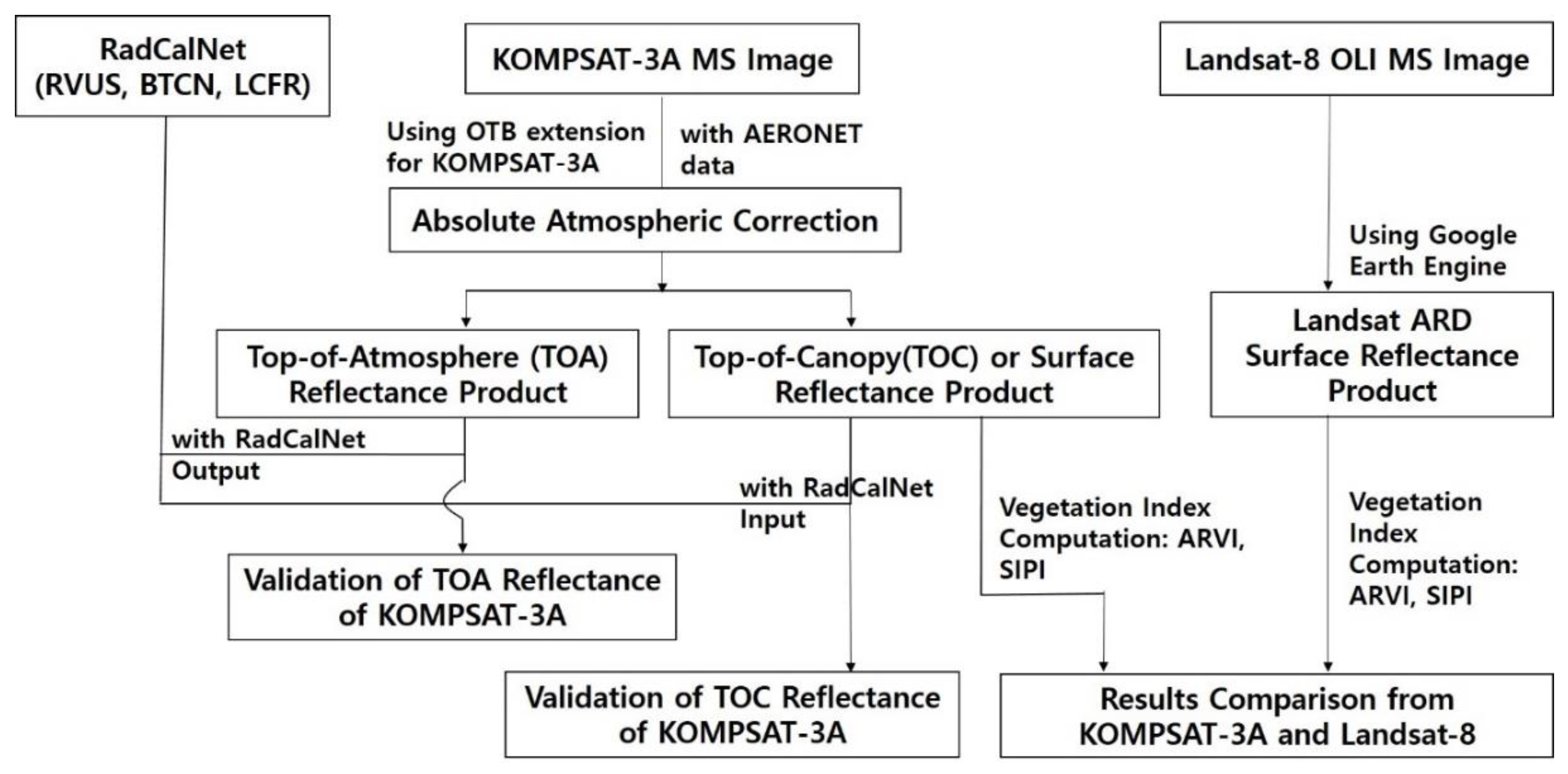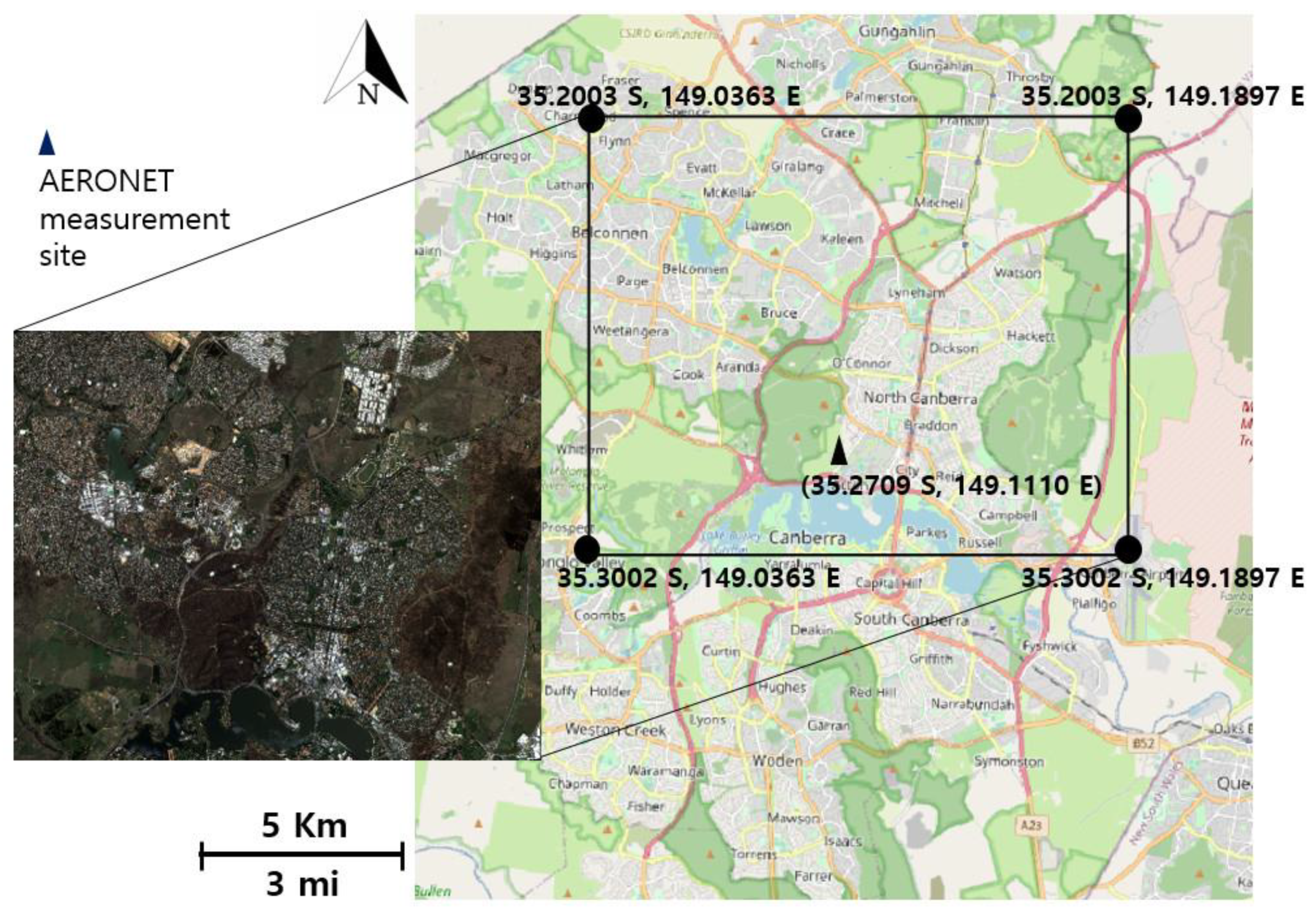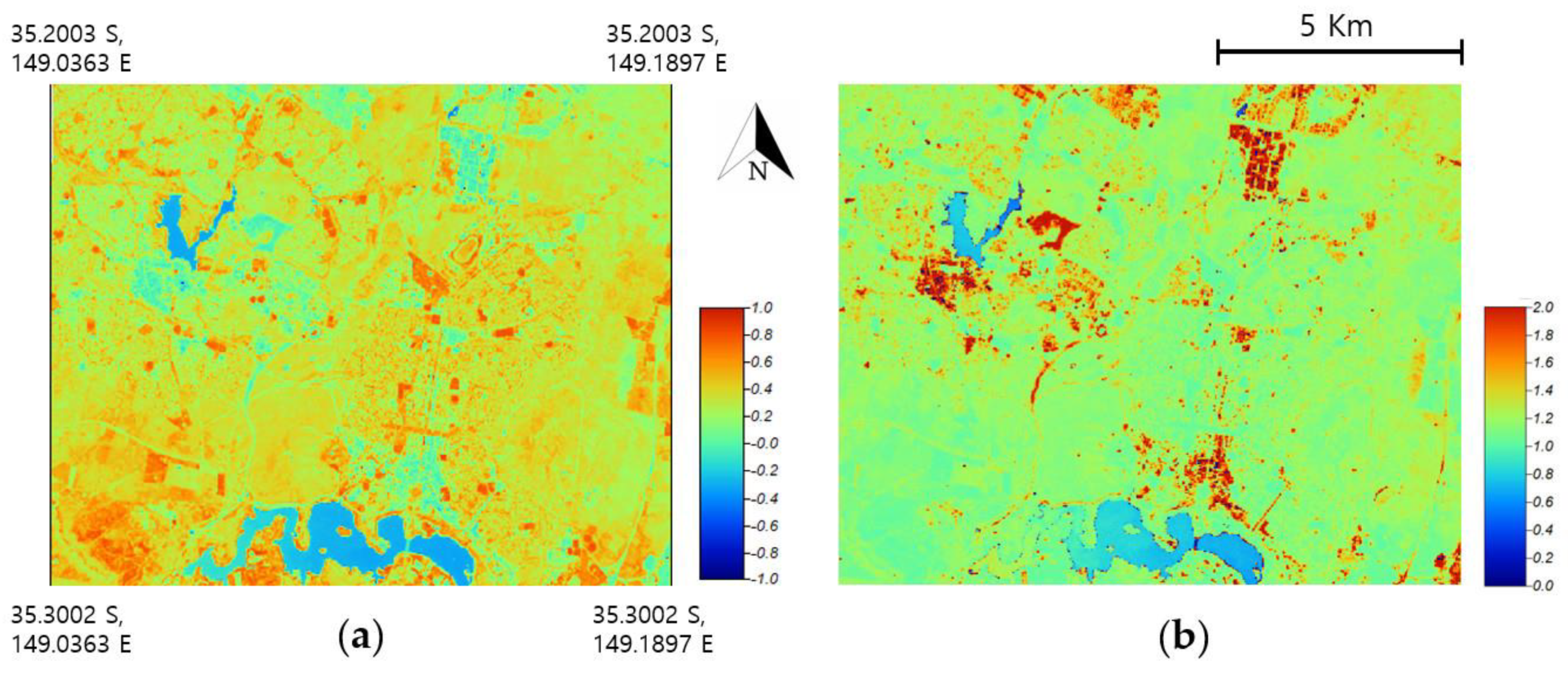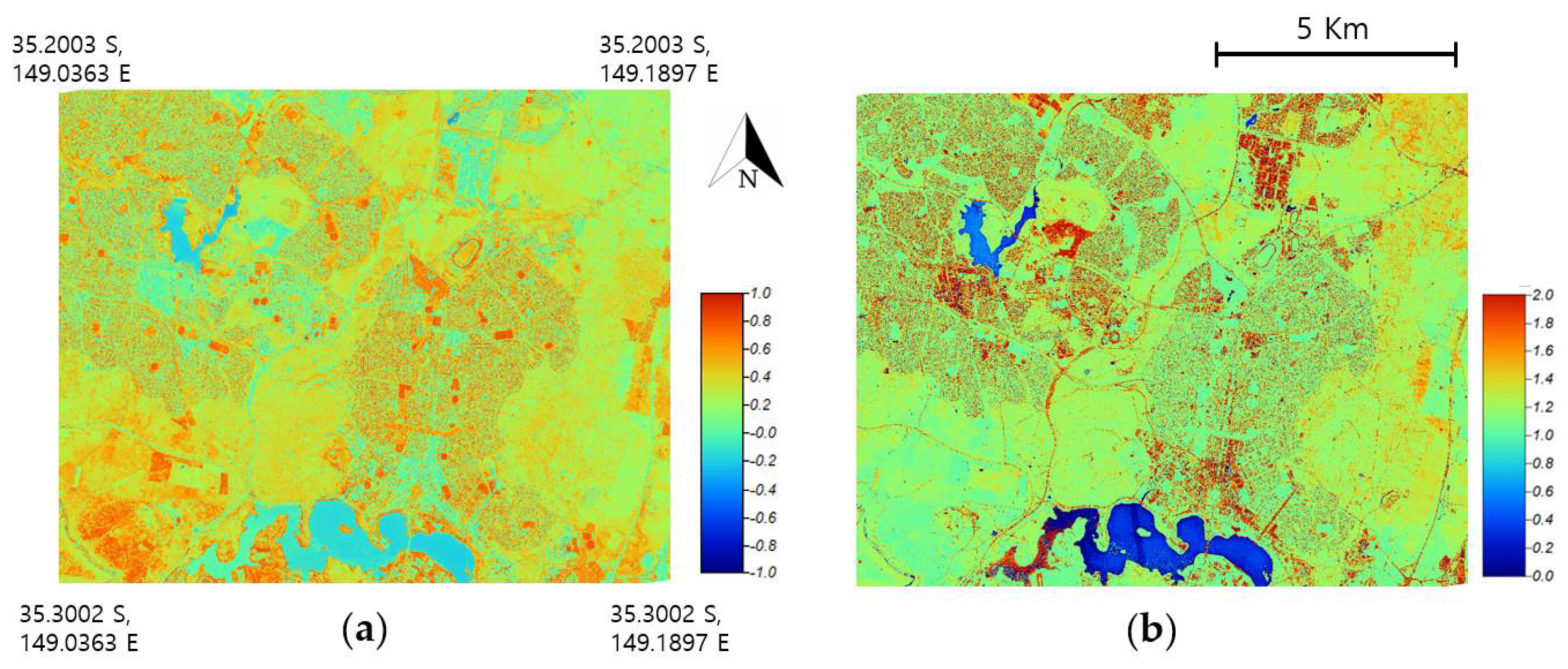A Validation Experiment of the Reflectance Products of KOMPSAT-3A Based on RadCalNet Data and Its Applicability to Vegetation Indexing
Abstract
:1. Introduction
2. Work Scope and Workflow
3. Results of Validation Experiment of KOMPSAT-3A with RadCalNet Data
4. Computation of Vegetation Indices: A Case Study
5. Discussion
6. Conclusions
Author Contributions
Funding
Acknowledgments
Conflicts of Interest
References
- Marcello, J.; Eugenio, F.; Perdomo, U.; Medina, A. Assessment of Atmospheric Algorithms to Retrieve Vegetation in Natural Protected Areas Using Multispectral High Resolution Imagery. Sensors 2016, 16, 1624. [Google Scholar] [CrossRef] [PubMed] [Green Version]
- Vanhellemont, Q.; Ruddick, K. Atmospheric correction of metre-scale optical satellite data for inland and coastal water applications. Remote Sens. Environ. 2018, 216, 586–597. [Google Scholar] [CrossRef]
- DigitalGlobe Atmospheric Compensation. Available online: http://digitalglobe-marketing.s3.amazonaws.com/files/documents/DataSheet_AComp_DS.pdf (accessed on 6 October 2020).
- Absolute Radiometric Calibration Is an Essential Tool to Imagery Science, but What Is It? Available online: https://blog.maxar.com/earth-intelligence/2020/absolute-radiometric-calibration-is-an-essential-tool-to-imagery-science-but-what-is-it (accessed on 2 October 2020).
- Chandra, S.N.R.; Christopherson, J.B.; Casey, K.A. Joint Agency Commercial Imagery Evaluation-Remote Sensing Satellite Compendium. 2020. Available online: https://pubs.er.usgs.gov/publication/cir1468 (accessed on 20 October 2020).
- Yeom, J.M.; Ko, J.; Hwang, J.; Lee, C.S.; Choi, C.U.; Jeong, S. Updating Absolute Radiometric Characteristics for KOMPSAT-3 and KOMPSAT-3A Multispectral Imaging Sensors Using Well-Characterized Pseudo-Invariant Tarps and Microtops II. Remote Sens. 2018, 10, 697. [Google Scholar] [CrossRef] [Green Version]
- Ahn, H.Y.; Kim, K.Y.; Lee, K.D.; Park, C.W.; So, K.H.; Na, S.I. Feasibility Assessment of Spectral Band Adjustment Factor of KOMPSAT-3 for Agriculture Remote Sensing. Korean J. Remote Sens. 2018, 34, 1369–1382, (In Korean with English Abstract). [Google Scholar] [CrossRef]
- Lee, K.; Kim, K. An Experiment for Surface Reflectance Image Generation of KOMPSAT 3A Image Data by Open Source Implementation. Korean J. Remote Sens. 2019, 35, 1327–1339, (In Korean with English Abstract). [Google Scholar] [CrossRef]
- Lee, K.; Kim, K.; Lee, S.; Kim, Y. Determination of the Normalized Difference Vegetation Index(NDVI) with Top-of-Canopy(TOC) Reflectance from a KOMPSAT-3A Image Using Orfeo ToolBox(OTB) Extension. ISPRS Int. J. Geo-Inf. 2020, 9, 257. [Google Scholar] [CrossRef] [Green Version]
- Grizonnet, M.; Michel, J.; Poughon, V.; Inglada, J.; Savinaud, M.; Cresson, R. Orfeo ToolBox: Open source processing of remote sensing images. Open Geospat. Data Softw. Stand. 2017, 2, 15. [Google Scholar] [CrossRef] [Green Version]
- Orfeo Toolbox. Open Source Processing for Remote Sensing Images. Available online: https://www.orfeo-toolbox.org/ (accessed on 10 October 2020).
- Bouvet, M.; Thome, K.; Berthelot, B.; Bialek, A.; Czapla-Myers, J.; Fox, N.P.; Goryl, P.; Henry, P.; Ma, L.; Marcq, S.; et al. RadCalNet: A Radiometric Calibration Network for Earth Observing Imagers Operating in the Visible to Shortwave Infrared Spectral Range. Remote Sens. 2019, 11, 2401. [Google Scholar] [CrossRef] [Green Version]
- Jing, X.; Leigh, L.; Pinto, C.T.; Helder, D. Evaluation of RadCalNet Output Data Using Landsat 7, Landsat 8, Sentinel 2A, and Sentinel 2B Sensors. Remote Sens. 2019, 11, 541. [Google Scholar] [CrossRef] [Green Version]
- Sterckx, S.; Wolters, E. Radiometric Top-of-Atmosphere Reflectance Consistency Assessment for Landsat 8/OLI, Sentinel-2/MSI, PROBA-V, and DEIMOS-1 over Libya-4 and RadCalNet Calibration Sites. Remote Sens. 2019, 11, 2253. [Google Scholar] [CrossRef] [Green Version]
- Wenny, B.N.; Thome, K.; Czapla-Myers, J. Evaluation of vicarious calibration for airborne sensors using RadCalNet. In Proceedings of the SPIE 11530, Sensors, Systems, and Next-Generation Satellites XXIV, Online Conference, 2 October 2020; p. 1153017. [Google Scholar] [CrossRef]
- Nouri, H.; Beecham, S.; Anderson, S.; Nagler, P. High Spatial Resolution WorldView-2 Imagery for Mapping NDVI and Its Relationship to Temporal Urban Landscape Evapotranspiration Factors. Remote Sens. 2014, 6, 580–602. [Google Scholar] [CrossRef] [Green Version]
- Warner, T.; Skowronski, N.S.; Gallagher, M.R. High spatial resolution burn severity mapping of the New Jersey Pine Barrens with WorldView-3 near-infrared and shortwave infrared imagery. Int. J. Remote Sens. 2017, 38, 598–616. [Google Scholar] [CrossRef]
- Yan, J.; Zhou, W.; Han, L.; Qian, Y. Mapping vegetation functional types in urban areas with WorldView-2 imagery: Integrating object-based classification with phenology. Urban For. Urban Green. 2018, 31, 230–240. [Google Scholar] [CrossRef]
- Solano, F.; Fazio, S.D.; Modica, G. A methodology based on GEOBIA and WorldView-3 imagery to derive vegetation indices at tree crown detail in olive orchards. Int. J. Appl. Earth Obs. 2019, 83, 101912. [Google Scholar] [CrossRef]
- Fang, F.; McNeil, B.; Warner, T.; Dahle, G.; Eutsler, E. Street tree health from space? An evaluation using WorldView-3 data and the Washington D.C. Street Tree Spatial Database. Urban For. Urban Green. 2020, 49, 126634. [Google Scholar] [CrossRef]
- Xue, J.; Su, B. Significant Remote Sensing Vegetation Indices: A Review of Developments and Applications. J. Sens. 2017, 2017, 1353691. [Google Scholar] [CrossRef] [Green Version]
- Tan, C.; Zhou, X.; Zhang, P.; Wang, Z.; Wang, D.; Guo, W.; Yun, F. Predicting grain protein content of field-grown winter wheat with satellite images and partial least square algorithm. PLoS ONE 2020, 15, e0228500. [Google Scholar] [CrossRef]
- Zarei, A.; Asadi, E.; Ebrahimi, A.; Jafari, M.; Malekian, A.; Nasrabadi, H.M.; Chemura, A.; Maskell, G. Prediction of future grassland vegetation cover fluctuation under climate change scenarios. Ecol. Indic. 2020, 119, 106858. [Google Scholar] [CrossRef]
- Somvanshi, S.S.; Kumari, M. Comparative analysis of different vegetation indices with respect to atmospheric particulate pollution using sentinel data. Appl. Comput. Geosci. 2020, 7, 100032. [Google Scholar] [CrossRef]
- RadCalNet Data Format Specification, QA4EO-WGCVRadCalNet-R2. Available online: https://www.radcalnet.org/resources/RadCalNetQuickstartGuide_20180702.pdf (accessed on 10 March 2020).
- AERONET. Aerosol Robotic Network. Available online: https://aeronet.gsfc.nasa.gov/ (accessed on 10 January 2020).
- USGS Landsat 8 Surface Reflectance Tier 1. Available online: https://developers.google.com/earth-engine/datasets/catalog/LANDSAT_LC08_C01_T1_SR (accessed on 10 September 2020).
- NDVI. Mapping a Function over a Collection, Quality Mosaicking. Available online: https://developers.google.com/earth-engine/tutorial_api_06 (accessed on 4 September 2020).
- TOA Radiance Reflectance Conversion of KOMPSAT 1.5. 2018. Available online: http://www.si-imaging.com/resources/?pageid=2&uid=284&mod=document (accessed on 2 October 2020).
- KOMPSAT-3A Image Data Manual v1.4. 2017. Available online: http://www.si-imaging.com/resources/?pageid=4&uid=234&mod=document (accessed on 2 October 2020).
- Thome, K.; Bouvet, M. Radiometric Calibration Network for Vicarious Calibration of Earth Observing Imagers in the Reflected Solar. Available online: https://earth.esa.int/documents/700255/4038549/2+thome_optical_radcalnet.pdf (accessed on 2 October 2019).
- Ma, L.; Zhao, Y.; Woolliams, E.R.; Dai, C.; Wang, N.; Liu, Y.; Li, L.; Wang, X.; Gao, C.; Li, C.; et al. Uncertainty Analysis for RadCalNet Instrumented Test Sites Using the Baotou Sites BTCN and BSCN as Examples. Remote Sens. 2020, 12, 1696. [Google Scholar] [CrossRef]
- Lee, K.; Kim, K. Validation of Surface Reflectance Product of KOMPSAT-3A Image Data Using RadCalNet Data. Korean J. Remote Sens. 2020, 36, 167–178, (In Korean with English Abstract). [Google Scholar] [CrossRef]
- Kim, K.; Lee, K. Validation of Surface Reflectance Product of KOMPSAT-3A Image Data: Application of RadCalNet Baotou (BTCN) Data. Korean J. Remote Sens. 2020. submitted for publication (In Korean with English Abstract). [Google Scholar]
- Claverie, M.; Vermote, E.F.; Belen Franch, B.; Masek, J.G. Evaluation of the Landsat-5 TM and Landsat-7 ETM+ surface reflectance products. Remote Sens. Environ. 2015, 169, 390–403. [Google Scholar] [CrossRef]
- Spectral Indices on Top of NDVI to Make Your Vegetation Analysis Complete. Available online: https://eos.com/blog/6-spectral-indexes-on-top-of-ndvi-to-make-your-vegetation-analysis-complete/ (accessed on 30 March 2020).
- OpenStreetMap. Available online: www.openstreetmap.org (accessed on 30 October 2020).
- Available online: https://custom-scripts.sentinel-hub.com/custom-scripts/sentinel-2/arvi/ (accessed on 2 September 2020).
- Available online: https://custom-scripts.sentinel-hub.com/custom-scripts/sentinel-2/sipi1/ (accessed on 2 September 2020).
- Radiometric Use of WorldView-3 Imagery. Available online: https://dg-cms-uploads-production.s3.amazonaws.com/uploads/document/file/207/Radiometric_Use_of_WorldView-3_v2.pdf (accessed on 25 November 2020).
- Frantz, D. FORCE—Landsat + Sentinel-2 Analysis Ready Data and Beyond. Remote Sens. 2019, 11, 1124. [Google Scholar] [CrossRef] [Green Version]
- Available online: http://ceos.org/ard/files/PFS/SR/v5.0/CARD4L_Product_Family_Specification_Surface_Reflectance-v5.0.pdf (accessed on 2 October 2019).
- Poussin, C.; Guigoz, Y.; Palazzi, E.; Terzago, S.; Chatenoux, B.; Giuliani, G. Snow Cover Evolution in the Gran Paradiso National Park, Italian Alps, Using the Earth Observation Data Cube. Data 2019, 4, 138. [Google Scholar] [CrossRef] [Green Version]
- Potapov, P.; Hansen, M.C.; Kommareddy, I.; Kommareddy, A.; Turubanova, S.; Pickens, A.; Adusei, B.; Tyukavina, A.; Ying, Q. Landsat Analysis Ready Data for Global Land Cover and Land Cover Change Mapping. Remote Sens. 2020, 12, 426. [Google Scholar] [CrossRef] [Green Version]
- Ong, C.; Thome, K.; Kuze, A. Role of CEOS Working Group on Calibration and Validation in Analysis Ready Data Products. In Proceedings of the IEEE International Geoscience and Remote Sensing Symposium, Yokohama, Japan, 28 July–2 August 2019; pp. 5538–5540. [Google Scholar]
- USGS EROS. Landsat Play Major Roles in Development of CEOS CARD4L. Available online: https://www.usgs.gov/center-news/usgs-eros-landsat-play-major-roles-development-ceos-card4l (accessed on 25 November 2020).







| Date | Band | TOA Reflectance Range in the RadCalNet Output | TOA Reflectance Value of KOMPSAT-3A | TOC Reflectance Range in the RadCalNet Input | TOC Reflectance Value of KOMPSAT-3A |
|---|---|---|---|---|---|
| 2 December 2016 | Blue | 0.2373–0.2445 | 0.2100 | 0.1841–0.2335 | 0.1700 |
| Green | 0.2475–0.2621 | 0.2200 | 0.2439–0.2900 | 0.2000 | |
| Red | 0.2677–0.2909a | 0.2600a | 0.2930–0.3118 | 0.2700 | |
| NIR | 0.2619–0.3327 | 0.2900 | 0.3310–0.3376c | 0.3100c | |
| 4 May 2018 | Blue | 0.2912–0.3204 | 0.2500 | 0.2610–0.3230 | 0.2300 |
| Green | 0.3256–0.3446b | 0.2800b | 0.3350–0.3859d | 0.2600d | |
| Red | 0.3568–0.3875 | 0.3300 | 0.3912–0.4114 | 0.3300 | |
| NIR | 0.3428–0.4194 | 0.3500 | 0.4246–0.4313 | 0.3800 |
| Date | Band | TOA Reflectance Range in the RadCalNet Output | TOA Reflectance Value of KOMPSAT-3A | TOC Reflectance Range in the RadCalNet Input | TOC Reflectance Value of KOMPSAT-3A |
|---|---|---|---|---|---|
| 31 October 2016 | Blue | 0.1700–0.1825 | 0.2100 | 0.1099–0.1416 | 0.1500 |
| Green | 0.1574–0.1681 | 0.1900 | 0.1453–0.1583 | 0.1500 | |
| Red | 0.1524–0.1620 | 0.2100 | 0.1563–0.1585 | 0.2100 | |
| NIR | 0.1283–0.1574b | 0.2200b | 0.1391–0.1545d | 0.2300d | |
| 5 August 2017 | Blue | 0.1758–0.1801 | 0.2100 | 0.1191–0.1576 | 0.1700 |
| Green | 0.1812–0.1860 | 0.2100 | 0.1630–0.1910c | 0.1800c | |
| Red | 0.1887–0.2012 | 0.2300 | 0.1964–0.2010 | 0.2300 | |
| NIR | 0.1532–0.2029 | 0.2400 | 0.1904–0.2062 | 0.2600 | |
| 30 November 2018 | Blue | 0.1915–0.1975 | 0.1700 | 0.1225–0.1656 | 0.1100 |
| Green | 0.1855–0.1908 | 0.1500 | 0.1714–0.1986 | 0.1200 | |
| Red | 0.1881–0.2009 | 0.1800 | 0.2006–0.2024 | 0.1800 | |
| NIR | 0.1562–0.1985a | 0.1900a | 0.1757–0.2004 | 0.2000 |
| Date | Band | TOA Reflectance Range in the RadCalNet Output | TOA Reflectance Value of KOMPSAT-3A | TOC Reflectance Range in the RadCalNet Input | TOC Reflectance Value of KOMPSAT-3A |
|---|---|---|---|---|---|
| 10 August 2016 | Blue | 0.1447–0.1496 | 0.1300 | 0.0813–0.1174 | 0.0700 |
| Green | 0.1481–0.1719 | 0.1300 | 0.1240–0.1765 | 0.1000 | |
| Red | 0.1857–0.2078 | 0.1700 | 0.1916–0.2151 | 0.1600 | |
| NIR | 0.2058–0.2874b | 0.2200b | 0.2542–0.2916 | 0.2600 | |
| 25 Febuary 2019 | Blue | 0.1132–0.1408 | 0.1300 | 0.0399–0.0588 | 0.0600 |
| Green | 0.1102–0.1122a | 0.1100a | 0.0636–0.0934 | 0.0700 | |
| Red | 0.1116–0.1149 | 0.1100 | 0.0966–0.1080c | 0.1000c | |
| NIR | 0.1566–0.2205 | 0.2200 | 0.1963–0.2271d | 0.2700d |
Publisher’s Note: MDPI stays neutral with regard to jurisdictional claims in published maps and institutional affiliations. |
© 2020 by the authors. Licensee MDPI, Basel, Switzerland. This article is an open access article distributed under the terms and conditions of the Creative Commons Attribution (CC BY) license (http://creativecommons.org/licenses/by/4.0/).
Share and Cite
Kim, K.; Lee, K. A Validation Experiment of the Reflectance Products of KOMPSAT-3A Based on RadCalNet Data and Its Applicability to Vegetation Indexing. Remote Sens. 2020, 12, 3971. https://doi.org/10.3390/rs12233971
Kim K, Lee K. A Validation Experiment of the Reflectance Products of KOMPSAT-3A Based on RadCalNet Data and Its Applicability to Vegetation Indexing. Remote Sensing. 2020; 12(23):3971. https://doi.org/10.3390/rs12233971
Chicago/Turabian StyleKim, Kwangseob, and Kiwon Lee. 2020. "A Validation Experiment of the Reflectance Products of KOMPSAT-3A Based on RadCalNet Data and Its Applicability to Vegetation Indexing" Remote Sensing 12, no. 23: 3971. https://doi.org/10.3390/rs12233971
APA StyleKim, K., & Lee, K. (2020). A Validation Experiment of the Reflectance Products of KOMPSAT-3A Based on RadCalNet Data and Its Applicability to Vegetation Indexing. Remote Sensing, 12(23), 3971. https://doi.org/10.3390/rs12233971






